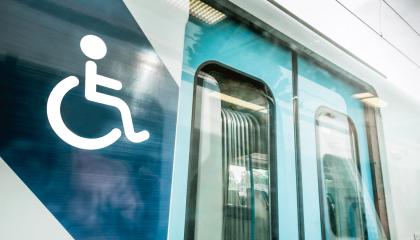At StrongGo, we aim to enhance urban accessibility with high-performance tactile warning surface indicators (TWSIs
In the realm of public safety, every detail matters. From bustling city sidewalks to expansive transportation hubs, ensuring the safety and accessibility of public spaces is incredibly important.
As urbanization continues to shape the world in 2023, creating accessible public spaces is more critical than ever. According to last year’s 2022 Valuable Truth Report, the disabled community represents $8 trillion per year in disposable income.
Traversing stairs can be dangerous for individuals, especially those with visual impairments. How would one detect a shift in level without risking their life? Detectable warning tiles, also known as truncated domes, work to inform pedestrians before trekking the stairs. The circular bumps on top of tactile warning surfaces indicate individuals to pause, avoiding tripping or falling.
Railway accessibility refers to the ease with which people can use the railway system, particularly those with disabilities or mobility issues. Ensuring that railways are accessible and approachable allows people with disabilities to travel independently and feel welcomed in society. Accessibility makes public transport more convenient for everyone, and it can improve public health by promoting active modes of transport such as walking and strolling.
Since the 1800s, people with disabilities pushed for recognizing disability as an aspect of identity that influences experiences and is not the sole-defining feature of a person. Unfortunately, harmful biases, assumptions, stereotypes, and irrational fears created a stigma around disabilities that followed a lack of advancements in access to public transportation, telephones, bathrooms, stores, office buildings, and other work sites. This stagnation left disabled individuals unable to find employment and kept them from opportunities for meaningful work.
Universal Design proposes an evolving and progressive approach to developing inclusive built environments, whether an office or public space, which are highly usable and accessible to all individuals. Accessibility is essential when it comes to developing an inclusive environment. Creating accessibility in learning environments and physical spaces requires extra planning and thought at the initial stages. Universal Design, when implemented, could standardize built spaces for all abilities.
Why do sidewalks have raised, colorful domes on sidewalk ramps? Why do airports have raised strips on walkways? Most people move throughout public spaces without understanding the purpose of these tactile surfaces underneath their feet. Yet, for specific people in our society, these tactile surfaces are the difference between independence and dependence.
Want to bike across the United States from east to west or west to east? Now, you can with the aid of the Great American Rail-Trail, a pathway that stretches 3,700 miles (6,000 km) across 12 states that will serve bikers, hikers, and riders.
Throughout the pandemic, bike paths and hiking trails regained their standing within society as an important and invaluable recreation option. Moreover, biking and walking were rated higher and higher for commutes with individuals who didn’t want the close confines of public transportation.
First and foremost, detectable warning tiles and surfaces were designed to assist individuals with disabilities to safely navigate public spaces, and then, in 1991, the Americans with Disabilities Act (ADA) mandated the use of detectable warning tiles in public areas throughout the United States.
Pagination
- Page 1
- Next page
Connect with us
We pride ourselves on our customer service, and we'd love to hear from you! Sign up for our newsletter to keep up with industry updates and trends, as well as any new product releases.












